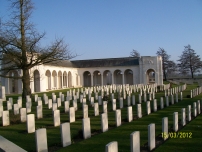| First Name: | Albert Robert | Last Name: | KING | |
|---|---|---|---|---|
| Date of Death: | 22/10/1914 | Lived/Born In: | Balham | |
| Rank: | Private | Unit: | Cornwall Light Infantry1 | |
| Memorial Site: | Le Touret Memorial | |||
Current Information:Age-21 55, Laitwood Road, Balham
The Race to the Sea - September-October 1914 By the middle of September 1914, the Aisne battlefield had stagnated into trench warfare and in order to break this impasse, both sides tried to outflank each other in a general movement northwards. Moving up through Picardy, Artois and Flanders, the race was over by 19th October when the North Sea was reached. The Western Front, a line of trenches stretching from Belgium to Switzerland, was now a reality. Initially it was the French army that conducted this movement whilst the British Expeditionary Force remained on the Aisne but by 6 October British reinforcements were needed to help beat off German attacks around Lille. They moved north and along with reinforcements from Britain, they took up new positions in Flanders, on the left of the Allied line and much closer to the Channel ports. The battle of La Bassée This was fought by II Corps (3rd and 5th Divisions) between 10th October and 2nd November 1914 and as the name suggests it focused on an area around the town of La Bassée in northern France. It was part of the Race to the Sea and it determined the line of the Western Front in that sector. There were some initial British successes but La Bassée remained firmly in German hands. German reinforcements arrived and the village of Neuve Chapelle was captured by them. Towards the end of October, the fighting on this front died down as the attention of both armies switched to Ypres. On 21st October a heavy German offensive developed against 3rd Division on the left of II Corps and at 7am, under the cover of mist, there was a particularly strong attack against 7 and 9 Brigades between Le Transloy and Herlies. A gap opened up in the British lines but German attempts to extend this gap were prevented in part by the stand made by the 1st Cornwall Light Infantry battalion of 14 Brigade, 5th Division, at the southern edge of the gap. During this, D Company on the left of the battalion line were attacked from front and left flank, surrounded and, all except one platoon, who had been holding forward posts, were either killed, wounded or taken prisoner. The rest of the battalion rallied, the gap was plugged and with the assistance of a company from 1st Royal West Kent, the line was restored. Other strong German attacks continued throughout the day and that night the battalion withdrew their line to conform with the rest of the divisional front. On the following day, 22nd October, 1st Cornwall Light Infantry remained in the line and at 3am they came under a strong attack which they managed to repel. By the time they were relieved later that day, 1st Cornwall had lost, in one way or another, over 250 of their number including Albert King. |
||||
| « Back to Search Results | ||||
| If you think any of the information shown here is incorrect, Click Here to submit your amends and comments | ||||




